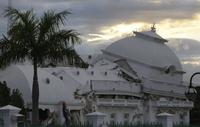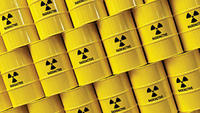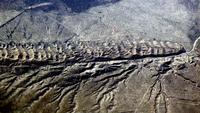-
Danger building up behind aging, vulnerable dams
Of the U.S. 85,000 dams, more than 4,400 are considered susceptible to failure; a 2009 report put the cost of fixing the most critical dams — where failure could cause loss of life — at $16 billion over twelve years, with the total cost of rehabilitating all dams at $51 billion; those figures do not include dams among the approximately 3,000 that are owned by the federal government; the Army Corps of Engineers, for example, says that more than 300 of the roughly 700 dams it is responsible for need safety-related repairs, and estimates the total fix-up bill at about $20 billion
-
-
Satellite system to provide earlier earthquake warnings
British and Russian scientists are planning a satellite system that will monitor seismic activity from space in the hope of one day predicting the occurrence of earthquakes and volcanic eruptions.
The TwinSat project will put one micro-sized and one nano-sized satellite into low earth orbit some 400 kilometers apart, which will work in unison to collect and interpret electromagnetic signatures from the ground -
-
Oil giants struggle to find more oil
Last week Exxon Mobil Corp’s annual financial report showed that the world’s largest oil company was struggling to find more oil; the report revealed that Exxon had only replaced 95 percent of the oil that it pumped out of the ground over the last decade; Exxon now holds more natural gas reserves than oil for future production; the company has replaced its natural gas reserves at higher rates than oil; in recent years large western oil companies have found that most of the accessible oil fields have been tapped, while new regions have been difficult to access both technically and politically; in 2010 Chevron announced that it had only replaced one barrel for every four it produced and Royal Dutch Shell PLC recently announced that next year it will produce more gas than oil for the first time in its company’s 104-year history
-
-
Haiti's quake damage yields better building codes

In the aftermath of the 7.0 magnitude earthquake that shook Haiti last year and killed more than 300,000 people, University of Arizona researchers descended upon the country’s capital to study buildings that survived the quake; researchers documented damaged buildings to develop a sophisticated three dimensional model; they are working to develop stricter building codes to ensure that buildings can withstand earthquakes in the future; their focus is on designing low-cost easy to implement localized solutions; buildings that were not built to withstand earthquakes were the primary cause of death in the disaster
-
-
California Delta plan released, canal recommendation missing
Last week the Delta Stewardship Council released the first draft of its proposed plan to resolve safety concerns over California’s Sacramento-San Joaquin River Delta, one of the state’s most critical pieces of infrastructure; the Delta accounts for 76 percent of the state’s fresh water supply; engineers, residents, and politicians fear that the aging levees along the Delta will break in the event of an earthquake; missing from the initial draft is a recommendation for a peripheral canal, a controversial proposal that has sparked fierce debate; more details will be added to the plan in subsequent drafts after public meetings are held to debate its contents; the final draft of the plan is scheduled to be completed and adopted in November 2011
-
-
States challenge federal policy on nuclear waste storage

The search for a permanent solution to the storage of nuclear waste continues as three states sued the Nuclear Regulatory Commission (NRC) last week over its new policy on spent fuel; in December NRC issued a new policy stating that nuclear waste could be safely stored at a power plant for sixty years after a reactor went out of service; the issue of nuclear storage has become increasingly contentious after the Obama administration ruled out the use of a Department of Energy storage site in Nevada in 2009; nuclear plants have been forced to turn temporary on-site storage into long-term facilities as no permanent site has been built; the Obama administration launched a commission to find alternatives for the permanent nuclear storage site in Nevada that it cancelled
-
-
Industry wants current safety law extended rather than see it toughened
Before the House Homeland Security committee, Timothy J. Scott, the chief security officer of Dow Chemical Co., urged Congress permanently to reauthorize the Chemical Facility Anti-Terrorism Standards (CFATS) bill; under CFATS chemical facilities are required to address a range of critical security concerns including protecting facilities against attacks and preventing the theft of dangerous chemicals; currently, more than 35,000 facilities that use or store chemicals are required to meet CFATS regulations; DHS has worked with facility owners to mitigate risks with custom developed security plans at more than 2,000 “high risk” sites
-
-
Safer wind turbine developed to minimize DHS objections

In the past wind turbine farms have faced opposition from the Department of Defense (DOD) and the Federal Aviation Administration (FAA) due to the interference they cause radar systems; wind turbines distort radars causing air traffic controllers to see them as storms and the interference generated by the wind farms can even cause planes to disappear completely from radar screens; a new wind turbine model will help minimize the impact that wind turbine fields have on radars; the model will be used by various government agencies including DHS, DOD, and the Department of Energy to decide whether a proposed wind farm can move forward
-
-
Rising seas will affect major U.S. coastal cities by 2100
The Gulf and southern Atlantic coasts will be particularly hard hit by rising sea levels, research predicts. Miami, New Orleans, Tampa, Florida, and Virginia Beach, Virginia could lose more than 10 percent of their land area by 2100
-
-
Boston has new pot-hole weapons
In a typical year, the city of Boston fills about 19,000 potholes; the city now has two new pot-hole weapons in its arsenal: a $151,300 Pro-Patch Pothole Patcher truck, and a new iPhone and Android app, called Street Bump, which would automatically report potholes to the city by sensing when a car has hit a bump (the app has not been released yet, but test-drives are already being conducted)
-
-
Be prepared: earthquakes big and small

The February issue of the Bulletin of the Seismological Society of America offers insights into small seismic problems — and big ones — the United States faces; there were a series of small tremors in the Dallas-Forth Worth area — home to more than four million residents that has experienced no previous earthquakes in historic time; the Coachella Valley section of the San Andreas fault, between San Gorgonio Pass and the Imperial Valley, is the only portion of the fault which has not ruptured in a major earthquake during historical time; this is not good news: This long period of quiescence suggests that an unusually large amount of elastic strain has built up along the southern San Andreas segment, making it likely to produce a large to great (Mw7-8) earthquake in the near future
-
-
Hoover Dam is safe from hackers
In response to the debate over the controversial Senate Internet “kill switch” bill, the U.S. Bureau of Reclamation refuted a central argument that the law’s proponents have been using; proponents of the bill have often stated the need for the bill because terrorists could hack into the system and open the Hoover Dam’s floodgates; the dam is not connected to the Internet and has several physical and technological safeguards that prevent the floodgates from opening; the proposed bill would authorize the president to sever critical infrastructure from the Internet in the event of a cyber attack; critics say the bill could violate First Amendment rights
-
-
U.K. plans new body for the regulation of nuclear power
The United Kingdom is setting up a new nuclear regulatory body; the Office for Nuclear Regulation (ONR) would be a new independent regulator, formally responsible in law for delivering its regulatory functions and consolidating civil nuclear and radioactive transport safety and security regulation in one entity
-
-
Smart fence distinguishes real from imagined threats
A new sensor system can tell between someone simply leaning against a fence and a ne’er-do-well sneaking around; the device, developed by researchers at the University of Southern California, contains signal processing based on the way the brain works
-
-
Wind energy's dirty secret
Vast tracts of land have been turned into toxic wastelands to fuel the increasing demand for green energy; rare Earth metals like neodymium are critical components in wind turbines and electric cars, but the process to extract them is damaging to the environment; China, the world’s largest supplier of rare Earth metals, has largely ignored environmental considerations and left Inner Mongolia a widening sea of radioactive waste; the United States is currently ramping up production of rare Earth minerals, but is seeking to find more sustainable production methods; wind power still has fewer environmental repercussions than coal or oil
-
More headlines
The long view
Virtual Models Paving the Way for Advanced Nuclear Reactors
By Marguerite Huber
Computer models predict how reactors will behave, helping operators make decisions in real time. The digital twin technology using graph-neural networks may boost nuclear reactor efficiency and reliability.
